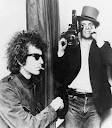Film: Dylan Revisited
D.A. Pennebaker looks back for the deluxe edition of 'Don't Look Back'
By Steven Rosen · March 7th, 2007 · Cincinnati CityBeat
For D.A. Pennebaker, the time has come to look back. For the new digitally remastered "deluxe edition" DVD of his classic documentary Don't Look Back, which followed Bob Dylan during a 1965 solo acoustic tour of England, Pennebaker went back to his unused footage to make a film called 65 Revisited.
In doing so, he found himself confronting and challenging the very essence of Don't Look Back. That film, shot verite-style, is as much a freewheelin' narrative about the pivotal tour as it is a concert film. Much of it occurs in rehearsal rooms and hotels before and after the shows.
It's especially about an edgy, prickly young Dylan -- just on the verge of transferring himself from folksinger into Rock & Roll star -- cagily sparring with the press and others who try to get to know him. While it has a generous number of songs performed onstage by Dylan, many are excerpted so as not to detract from the film's own pacing and behind-the-scenes glimpses.
65 Revisited is a companion piece to Don't Look Back rather than a replacement. It's just a shade over an hour, and in places the sound and lighting are problematic. But it nonetheless serves as a meaningful alternative, a new take.
For one, Dylan is relaxed and even boyishly sweet with the fans he meets. He's also honest rather than evasive when asked questions.
He's generally happy and shows it -- in one scene he smiles with delight hearing his new Rock & Roll single, "Subterranean Homesick Blues," on the radio.
And Revisited contains riveting, electrifying full concert performances of "It's All Over Now, Baby Blue," "She Belongs to Me," "To Ramona," "It's Alright Ma (I'm Only Bleeding)" and the rare "If You Gotta Go, Go Now." There are also short scenes of Dylan composing new songs "It Takes a Lot to Laugh, It Takes a Train to Cry" and "I'll Keep It With Mine" on piano.
Talking from his New York office, Pennebaker -- now 81 but still busy -- said the catalyst for Revisited came from his editor getting him to watch Don't Look Back's outtakes.
"It was like a towel being taken off my head," Pennebaker says. "I saw something I hadn't bothered to think much about for Don't Look Back. I saw that those performances themselves were really the whole reason Dylan had an effect on people.
"It wasn't just that he was this little Kerouac kid running around being funny with the press. It was those performances to those huge, hushed masses of English guys who thought it was poetry and music put together in an amazing way. So we sat down to make a film about that.
"I don't feel this knocks that one out of the box. It was just a further insight for me where I hadn't been looking before. The charisma that came off that stage when he got up and sang those songs is just startling."
When Pennebaker first agreed to make Don't Look Back, he knew virtually nothing about Dylan. He's still unsure why he was invited, although during the ensuing tour Dylan mentioned he had seen a documentary on cellist/conductor Pablo Casals that Pennebaker and partner Richard Leacock had shot for CBS.
"Albert Grossman (Dylan's manager) came into our office and asked would I be interested in accompanying his client to England for a tour," Pennebaker recalls. "It wasn't a job. I was going to have to pay for it, I suspected. But that was the offer and I said yeah.
"I think I knew one song by him, the one Peter, Paul & Mary were singing ('Blowin' in the Wind'), but I didn't know anything about him. I had read a piece in Time magazine suggesting he was a guy singing Folk music and wasn't very good at it. That sort of intrigued me."
Pennebaker thinks Dylan wanted to see how the director's intimate, fly-on-the-wall style of filmmaking worked.
"I think he wanted to see what making a film on this level was like -- not big-time filmmaking, just a single person. But I never knew, and he never talked about it."
The next year, when Dylan toured Europe with a Rock & Roll band called the Hawks, he directed a film called Eat the Document for an ABC special. Pennebaker served as his cameraman. Overly arty, that film was rejected by ABC and never released. Pennebaker prepared his own more straightforward film of that tour called You Know Something Is Happening. It, too, hasn't been released although portions were used in Martin Scorsese's 2005 Dylan film for PBS, No Direction Home.
Don't Look Back also is famous for starting with what has been called the first music video -- it opens in an alley, with Dylan holding up and discarding pertinent cue cards while "Subterranean Homesick Blues" plays on the soundtrack. His friend and road manager, Bob Neuwirth, and Allen Ginsberg stand in the distance. The deluxe set includes two alternate versions -- one shot in a park with Neuwirth and Ginsberg, another on a hotel rooftop with Neuwirth and record producer Tom Wilson.
"Originally, when I did the film I started off in the dressing room with Bob singing, 'You will start out standing (from the song 'She Belongs to Me'). I thought, 'That's a good way to start a film,' " Pennebaker says. "But as I looked at it before doing a final version, I said nobody knew who this guy is yet. So we had this thing we shot that we didn't have any reason for shooting. It was just a funny thing. I stuck it on the beginning and that was it. It never came off."




























